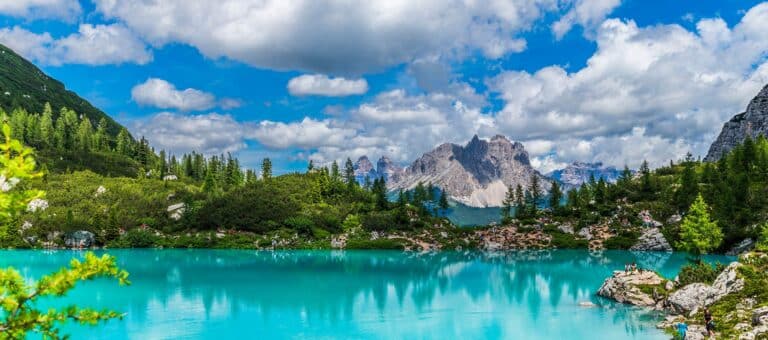Northern Italy is a little smaller than New York state, and its eight regions have a huge variety of scenic beauty for travelers to discover. For those who love alpine beauty, the Dolomites, Italian Alps, and more northern areas of the Italian Lakes is heaven. The Piedmont region has world-famous vineyards, and the coast of Liguria, more commonly known as the Italian Riviera, is awesome. The most-often visited northern city is Venice, but stylish Milan is a must. Padua, Verona, Mantua, and Trieste are historic gems, while Turin and Genoa sizzle with excitement. Below are the regions and the distinctive differences of each.
The Veneto
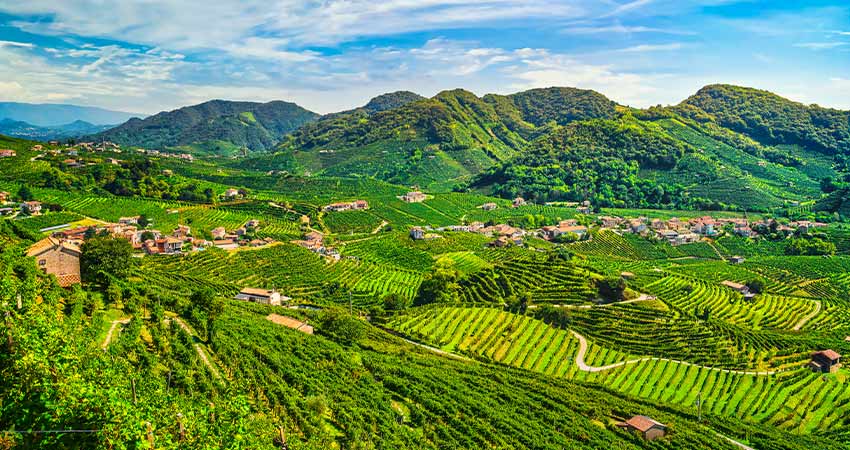
The Veneto region, part of the powerful Venetian republic for 1,000 years, is a study in astonishing contrasts. Stretching from the majestic Dolomite mountains to the Adriatic Sea, you can go hiking in the morning and wine-tasting in the afternoon. While you’re there, visit Treviso. It’s known for its Prosecco, rich red Bardolino and Amarone wine, and crisp Pinot Grigio and Soave. In short, Veneto produces some of the most distinctive Italian wines. (It’s also the home of tiramisu.) See the Fontana delle Tette, a 16th century fountain that was used to dispense wine. The village’s Duomo has a Romanesque crypt, and it houses a glorious painting by Titian.
Friuli-Venezia-Giulia
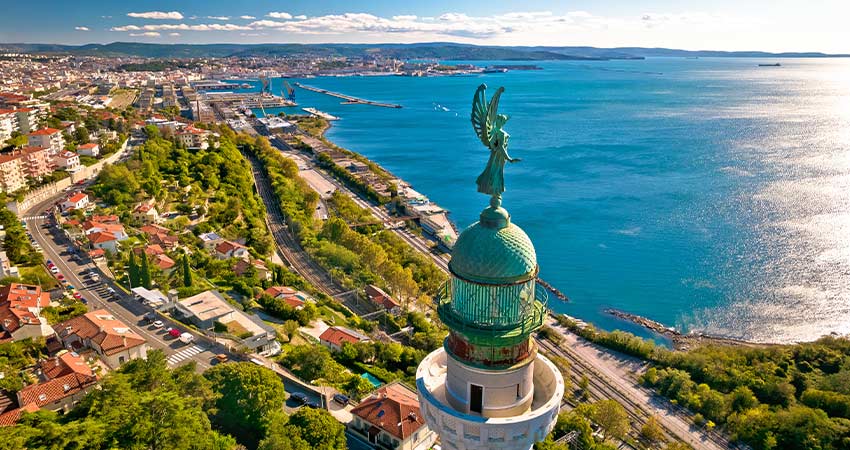
This small region is one of Italy’s lesser visited areas, which makes it very attractive to some travelers. In the northeast of Italy, it borders Austria, Slovenia, and the Adriatic Sea. This is the home of the stunning Dolomites, as well as vineyards that produce exceptional white wines. The capital, Trieste, was part of the Austro-Hungarian Empire and it was their window to the world.
A port city, Trieste may be the most diverse and quirky in Italy. Considered a literary and cultural center, the cafes are famous for good talk and fine food. (This port town brought coffee to Europe.) The center of old town is an Austrian Square, and there are beaches that hug the Adriatic Sea’s crystal waters. Only 99 miles from Venice, it is perfect for those looking for a distinctive difference.
Venice
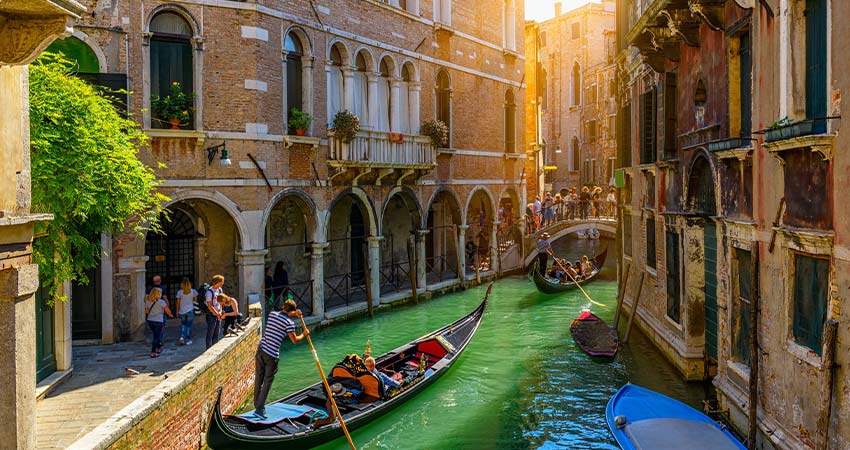
Venice, capital of the Veneto Region, is recognized as a UNESCO World Heritage Site. Situated in the northeast, Venice was the gateway to the Orient; in the 10th century it became a Byzantine province. Built on more than 100 small islands in an Adriatic lagoon, the city is filled with canals that carry gondolas, has a multitude of lovely bridges, and a misty feel of magic. The Piazza San Marco and the Piazzetta, dominated by the church of St Mark, are a testament to the city’s position as a world power from the 12th to 14th centuries.
After you’ve seen Venice’s highlights, consider going to Teatro la Fenice, one of Italy’s most popular opera houses. Built in 1792, there are complex gold carvings and plush red velvet seats; it is the best of Old World opulence. Head to Piazza San Marco and take the elevator to the top of the campanile (bell tower) for stunning views. On clear days, you can see the Alps. Be amazed by the stone lions at Arsenal. By the 16th century, the Arsenal was the greatest shipyard in the world, able to build an entire galley in 24 hours. Go to Burano island for traditional lace, and Murano for hand-blown glassware.
Verona
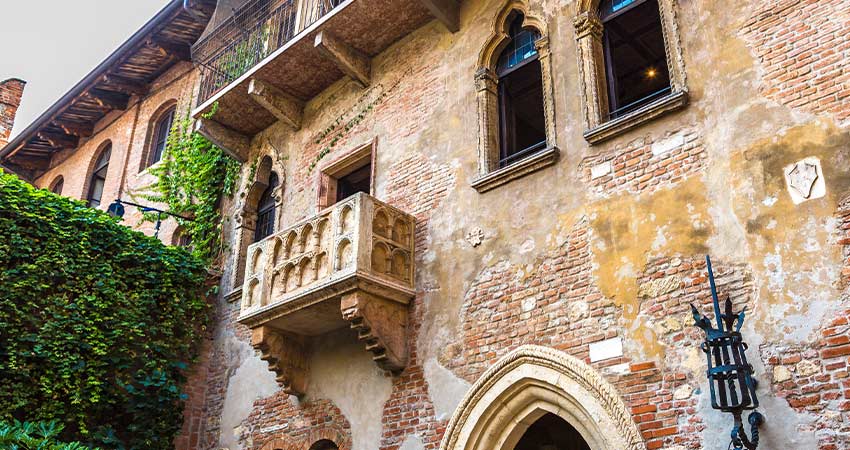
Verona is one of Italy’s most romantic destinations. Near the alpine Lake Garda, on the Adige River, medieval Verona is also part of Veneto and is a UNESCO World Heritage site. (Two of Shakespeare’s plays, Romeo and Juliet and Two Gentlemen of Verona were set here.) It became a Roman colony in 89 BC, then was taken in turn by the Visigoths, Lombards, Austrians, and was then batted back and forth between noble families for centuries. Verona finally became part of Italy in 1866. All this makes for very interesting architecture, artifacts, and explorations!
Visit the Roman Arena di Verona. Although 2,000 years old, it’s still a center of activity. It hosts a summer opera festival as well as today’s popular musicians. Head to the Piazza delle Erbe, one of the city’s loveliest and oldest Roman squares. It has a vibrant marketplace and a gorgeous statue of the Verona Madonna, created in 380 AD. The Museum of Castelvecchio (old castle) has 200 ancient artworks that were saved during Napoleon’s occupation. Foodies can sample local favorites such as Monte Veronese cheese, or sopressa salami paired with Valpolicella wine or espresso.
The Parco Natura Viva is a wildlife wonder. There are more than 1,500 animals from five continents, including red pandas, flamingos, lemurs, and chimpanzees. From there, you can go to Safari Park in search of antelopes and lions. For the young, and the young at heart, Verona has water parks and amusement parks. Relax and enjoy this city where the ancient and modern sit comfortably side by side.
Belluno
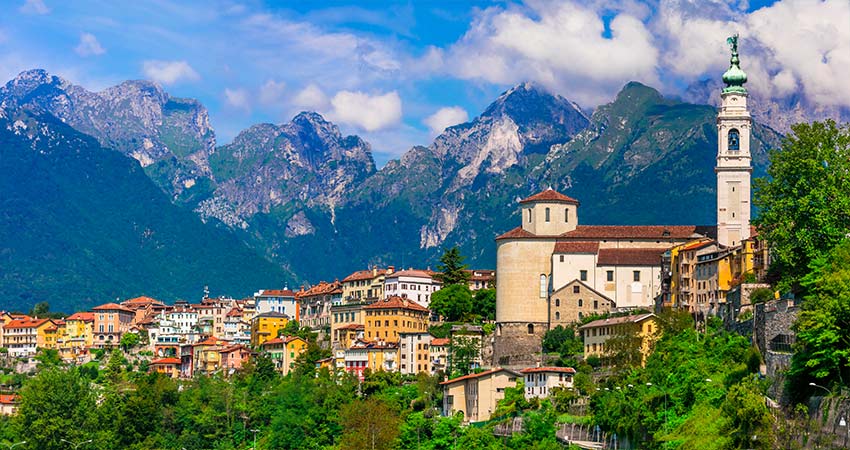
Belluno, also in the Veneto region, is part of the Dolomiti Bellunesi National Park and a UNESCO World Heritage site. Just 62 miles north of Venice, it’s a hub city for the Dolomites and a paradise for those who want to get into nature. This Alpine town, located on the Piave River, is also a romantic dream. The old city is filled with Gothic and Renaissance architecture, and you can explore the Piazza del Martiri and Piazza della Erbe for atmospheric art, fountains, and monuments. There are bell towers, a 16th century Duomo, and cafes with local food that’s a combo of Italian and Austrian. The Celts named this quiet holiday town belo-dunum, or resplendent city. It is.
Lombardy and the Lakes
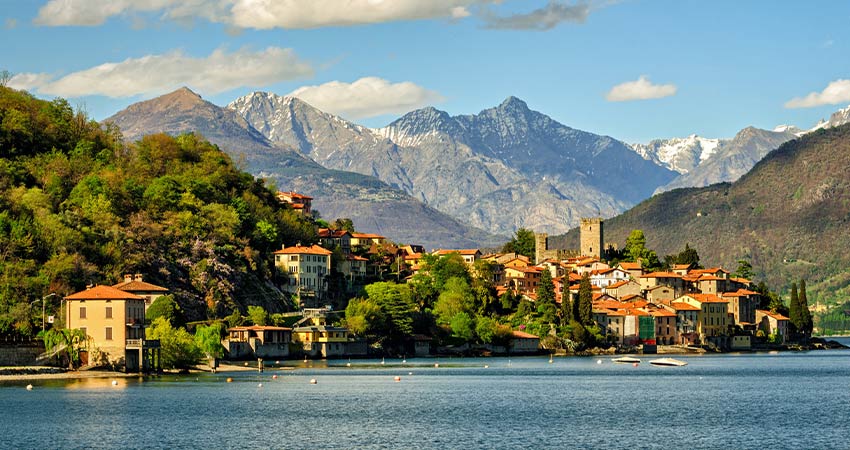
Lombardy is dotted with lakes carved by glaciers, but Lake Como, Maggiore, Garda, and Iseo are the largest. The lake shores were inhabited during prehistoric times. The Romans adored this area—Lake Como was their favorite retreat. Holiday villas were built here in the first century AD, Longfellow and Tennyson wrote here, and Liszt composed at Como. It is still a favored getaway for the rich and famous to kick back and luxuriate.
Churches, castles, and sanctuaries were built on the Lakes in the Middle Ages. You can still explore them! Walk the promenade on Lake Maggiore’s Stresa, or wander through Como, and you’ll experience villa gardens, vineyards, olive trees, oleanders, and palm trees. Lake Garda is the largest lake; even during the summer there are views of gorgeous snow-capped mountains. Go to the lovely 4th century Villa Romana or to Sirmione and you’ll discover a fascinating 13th century castle. There are also the ruins of a villa, Grote di Catullo, the home of the Roman poet Catullus.
Milan
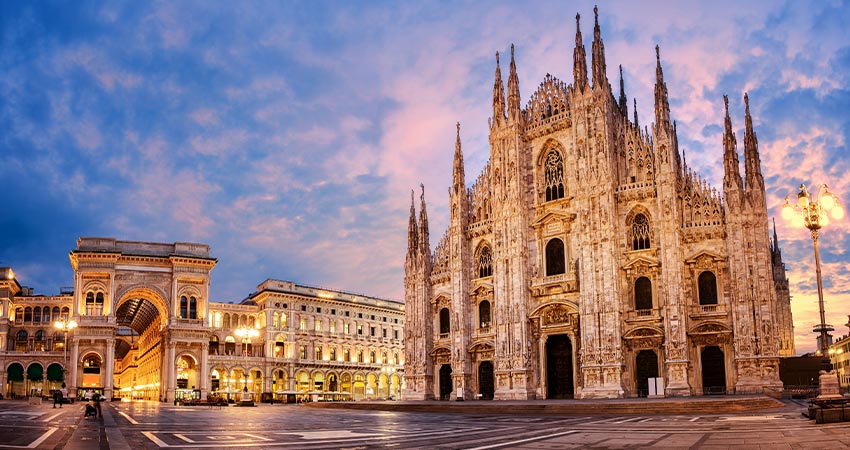
The capital of the Lombardy region, Milan is Italy’s economic engine and home of the national stock exchange. It is also stylish Italy’s fashion and design capital. (After all, this is where Giorgio Armani, Versace, Dolce & Gabbana, and Prada come from.) Considered to be the most ancient city in Europe, Milan dates back to 600 BC. It was founded by a Celtic tribe, and then taken over by the Romans. This city has just about everything we love about Italy: cuisine, history, art, architecture, culture, and style.
The heart of the city is dominated by its magnificent cathedral, extraordinary works of art, including Da Vinci’s Last Supper, the Teatro alla Scala opera company for the best operatic voices in the world, Sforza Castle, and the Basilica of Sant’Ambrogio. Go shopping at the legendary Galleria Vittorio Emanuele II. Then, head to one of the fabulous flea markets for ceramics, china, fabrics, and unique finds for your home. Wine tasting at il Secco wine vault is perfection, and you can dip into a small eatery for Brasilian sushi. There are restaurants with innovative and traditional cuisine on every street and lane. Milan is elegant, walkable, and holds surprises around every corner.
Valle D’Aosta and Piedmont
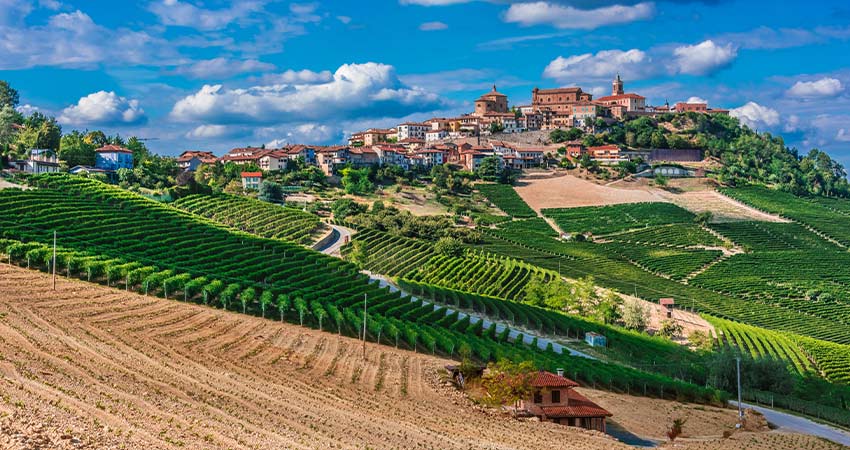
Next to France, and bordering the Alps, Valle D’Aosta and Piedmont were under the rulership of the House of Savoy until the 18th century. French culture can still be heard in local speech, and it can be tasted in the cuisine… French and Italian is a beautiful mix. The smallest region in Italy, it is ideal for travelers who want a new Italian experience and love mountain scenery and winter sports.
The Piedmont, situated at the base of the Alps, is foodie paradise. It is known for white truffles, fruits (dried and fresh), various nuts, a bonanza of cheeses, delicious veal, Barolo wine, and an abundance of vegetables. It is a major player in the Slow Food movement. Turin, its capital, has a wealth of baroque buildings. Go to Mole Antonelliana—its soaring tower is an inspiration. The main industry is automobiles, and there’s a fabulous museum celebrating sleek cars. The Egyptian Museum has a thrilling collection; it’s perfect after a truffle hunt!
Emilia-Romagna
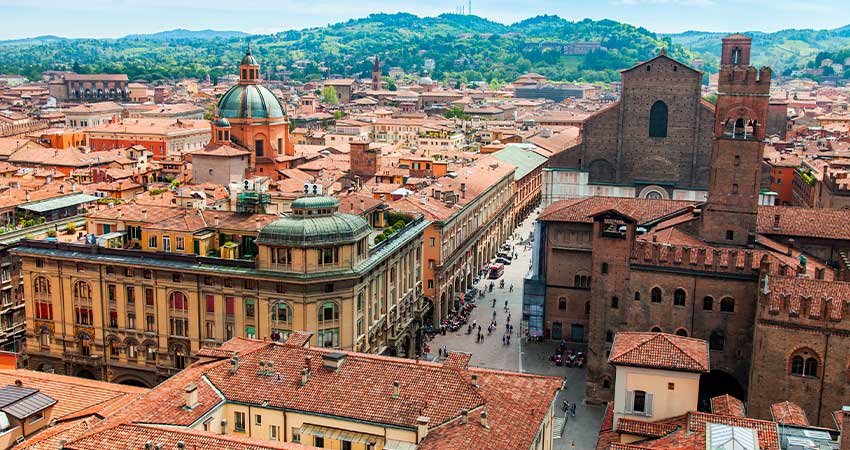
This northern Italy region is known for its brilliant beaches on the Adriatic Sea, medieval cities and villages, and some of the best food in Italy. The vibrant capital, Bologna, has an 11th century university. Its Piazza Maggiore is a huge plaza with arched colonnades, medieval and Renaissance architecture, the Fountain of Neptune, and the Basilica di San Petronio. The home of delicious Bolognese, indulge in perfect pasta and meat sauce. Another beautiful city in this region, Ravenna, is known for its wild Byzantine mosaics. And Parma, of course, for its cheeses.
Liguria
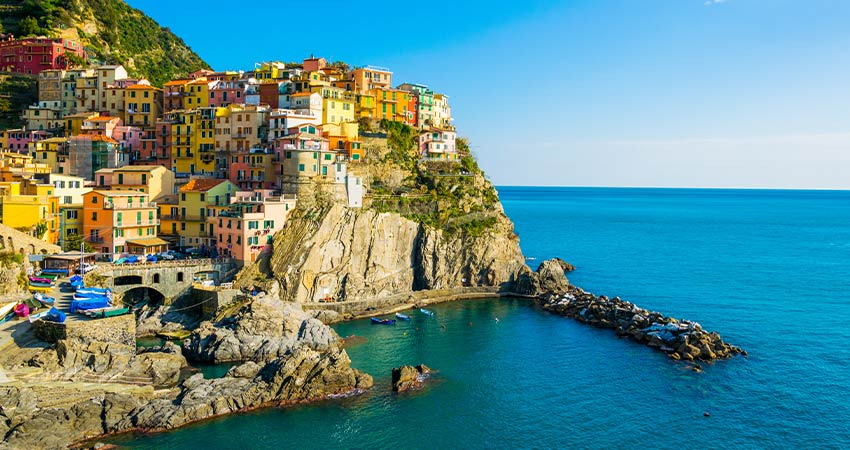
The Liguria region of Italy basks in the warm Mediterranean sun; this is the Italian Riviera. (The capital city is the historic port of Genoa.) The crescent moon-shaped coastline is home to Cinque Terre, with its five colorful fishing villages tumbling to the sea. You can also visit upscale Portofino on the east coast or Riviera de Levante. Next to Monaco, it’s easy to make a day trip to that world-renowned playground of yachts and classy casinos. On the west coast, the Riviera di Ponente is worth visiting so you can go to Sanremo with its turn-of-the-century vibe, casino, and promenade.
When you travel to the Italian Riviera you must experience its most famous dish, the luscious trofie al pesto. Trofie is hand-rolled pasta, and the pesto must be made from basil, garlic, extra-virgin Genovese olive oil, pine nuts, salt and two types of cheese from Rome, Tuscany, Sardegna, or Sicily. The air off the sea and the soil, rich in minerals, is perfect for growing herbs, vineyards, pine nuts, olive orchards, and porcini mushrooms. Come to the Italian Riviera prepared to wine, dine, laugh, and feel the essence of an authentic Italian experience.
Northern Italy is the economic engine that makes the country run. When you visit Northern Italy, you’re traveling though the most diverse part of the country. In the 18th century, the Lakes region was a stop for well-to-do families on a Grand Tour of Europe. The Italian Riviera is a magnet for indulging your senses. The regions of the Dolomites are made for those who want to feel the magnificent pull of nature. Northern Italy has everything, from Austrian food, Italian-French food, to the sunny Riviera. And Milan is the stylish and cultural capital of it all.
Let your Destination Expert know that you want a thrilling Italian culture and adventure vacation. Northern Italy awaits!









